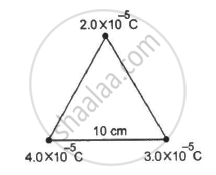Advertisements
Advertisements
प्रश्न
Suppose an attractive nuclear force acts between two protons which may be written as F=Ce−kr/r2. Write down the dimensional formulae and appropriate SI units of C and k.
उत्तर
Given, nuclear force of attraction,
\[F = C\frac{e^{- Kr}}{r^2}\]
Here e−Kr is just a pure number, i.e. a dimensionless quantity. So,
\[\left[ C \right] = \left[ F \right] \times \left[ r^2 \right]\]
\[\left[ C \right] = \left[ {MLT}^{- 2} \right] \times \left[ L^2 \right]\]
\[\left[ C \right] = \left[ {ML}^3 T^{- 2} \right]\]
C = kg ⋅ m3 ⋅ s −2
\[\text{ And } \left[ K \right] = \frac{1}{\left[ r \right]} = \left[ L^{- 1} \right]\]
SI units: m−1
APPEARS IN
संबंधित प्रश्न
Check that the ratio ke2/G memp is dimensionless. Look up a Table of Physical Constants and determine the value of this ratio. What does the ratio signify?
Suppose that the particle is an electron projected with velocity vx = 2.0 × 106 m s−1. If E between the plates separated by 0.5 cm is 9.1 × 102 N/C, where will the electron strike the upper plate? (|e| = 1.6 × 10−19 C, me = 9.1 × 10−31 kg)
Write any two important points of similarities and differences each between Coulomb's law for the electrostatic field and Biot-Savart's law of the magnetic field ?
Does the force on a charge due to another charge depend on the charges present nearby?
Two insulating small spheres are rubbed against each other and placed 1 cm apart. If they attract each other with a force of 0.1 N, how many electrons were transferred from one sphere to the other during rubbing?
Two small spheres, each with a mass of 20 g, are suspended from a common point by two insulating strings of length 40 cm each. The spheres are identically charged and the separation between the balls at equilibrium is found to be 4 cm. Find the charge on each sphere.
Two identical pith balls, each carrying a charge q, are suspended from a common point by two strings of equal length l. Find the mass of each ball if the angle between the strings is 2θ in equilibrium.
Two particles A and B possessing charges of +2.00 × 10−6 C and of −4.00 × 10−6 C, respectively, are held fixed at a separation of 20.0 cm. Locate the points (s) on the line AB, where (a) the electric field is zero (b) the electric potential is zero.
A water particle of mass 10.0 mg and with a charge of 1.50 × 10−6 C stays suspended in a room. What is the magnitude of electric field in the room? What is its direction ?
How much work has to be done in assembling three charged particles at the vertices of an equilateral triangle, as shown in the figure?
Write a short note on superposition principle.
Explain in detail Coulomb’s law and its various aspects.
A total charge Q is broken in two parts Q1 and Q2 and they are placed at a distance R from each other. The maximum force of repulsion between them will occur, when ____________.
Polarised dielectric is equivalent to ______.
Two point charges +3 µC and +8 µC repel each other with a force of 40 N. If a charge of -5 µC is added to each of them, then force between them will become ______.
For charges q1 and q2 separated by a distance R the magnitude of the electrostatic force is given by ______.
Identify the wrong statement in the following.
Coulomb's law correctly describes the electric force that ______
Which of the following statements about nuclear forces is not true?
